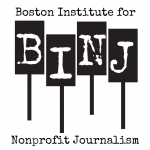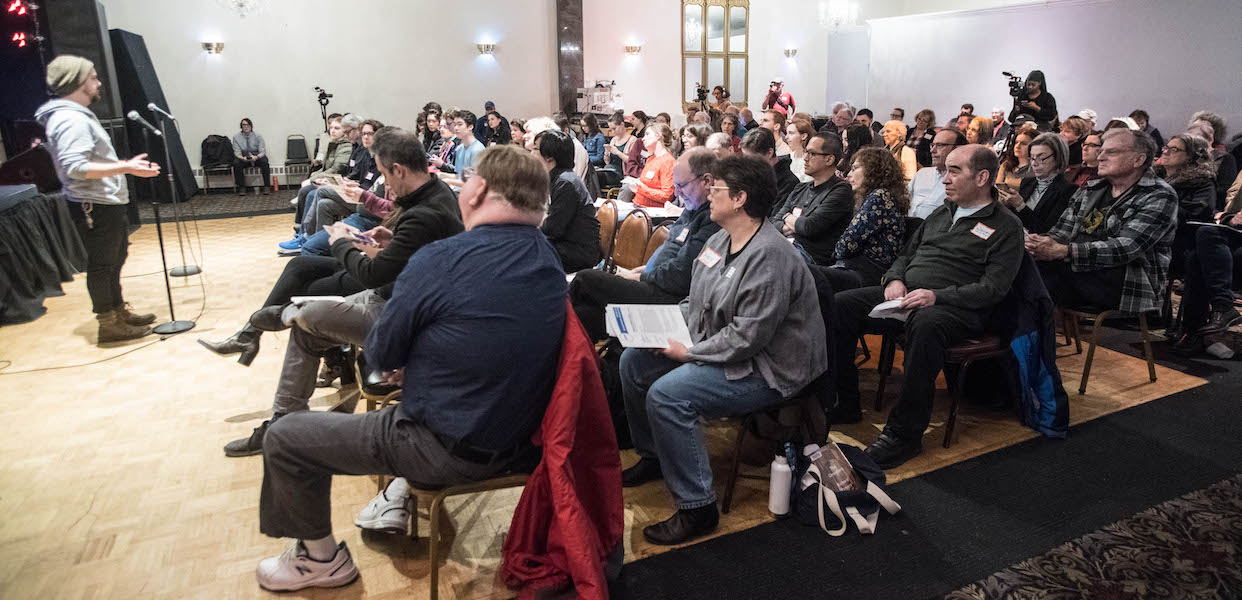Residents vent on issues related to neighborhoods, transit, and accessibility
As a major initiative for 2019, the team at the Boston Institute for Nonprofit Journalism (BINJ), in collaboration with partners at DigBoston, Somerville Media Center (SMC), and various other outlets, is focusing on identifying and reporting critical stories in the City of Somerville.
To that end, we have been leading journalism workshops at SMC, including some with high school students, and in February BINJ turned out more than 100 Somerville residents and active community members to the ONCE ballroom on Highland Ave to converse with area journalists about issues they think need more coverage. The information these participants provided has already seeded articles and will continue to bear fruit over the coming months.
In addition to our follow-ups, we have transcribed all of the presentations given at ONCE. It’s a lot to chew on, so for the purpose of reporting back we parsed sentiments of the participating Somervillians into the following categories (many of which overlap at multiple intersections):
- Neighborhoods, transit, and accessibility
- Union Square and other development
- Low-income residents and affordable housing
- Immigrant communities
- Trees and the environment
- Arts, artists, and artisans
In addition to reports that stem from the February meetup, over the coming weeks we will also publish words and ideas that stood out at the summit. Starting this week with excerpts from various testimonies related to neighborhoods, transit, and accessibility.
Mary Mangan, Winter Hill Neighborhood Association
Who are the property owners sitting on huge vacant lots and vacant storefronts? I’ve had three people here asking me about the Star Market [property]. Who are the developers landing all the big projects? … What’s happening in the schools? Are they actually improving outcomes for students with the most barriers? Or are schools just shifting to more affluent demographics?
We want to connect and align with other neighborhood or issue groups doing similar things … and it’s hard to know who and where this is. Reaching and engaging renters is particularly hard for us; we have the same homeowners showing up for most of our meetings. …
Urban environment issues are of concern to us and urban health issues that are more specific to city living. ResiStat was a great idea initially but we never get beyond the city marketing information anymore. We aren’t digging into the data on restaurant inspections, licenses, health department stuff, recreation department events.
Justin Moeling, Gilman Square Neighborhood Association
As the Green Line extension representative to the community working group for the Gilman Square Station area, I get to meet a lot of my neighbors. They’ve had a lot of conversations about station design [and how] Gilman Square actually doesn’t have direct access to the Gilman Square Station.
One of the things that we realized is that [in] Gilman Square, some people don’t even know that Gilman Square exists. … There’s going to be a lot of development that happens in that area … there’s really going to be an upswell of development and just endless opportunities.
Last March a few of us got together and formed the Gilman Square Neighborhood Association. … It’s an interesting situation in which we already had the Winter Hill Neighborhood Association. … They’re awesome, but … we needed a voice that was collective for [Gilman Square].
We were able to advocate with the city and GLX [Green Line Extension representatives from the state] and elected officials in order to get the pedestrian bridge open on School Street, and we’re really working to be active with neighbors in the community that are engineers and architects to have the community at the table with developers in the city in developing Gilman Square. We hope that folks [who] live in the neighborhood join us.
Ellin Reisner, Somerville Transportation Equity Partnership
We were founded around 2003 by community residents concerned about getting the Green Line extension brought here and we’ve been working on it since then. … The design issues are really of great concern. Not just for now, but for the long term of the City of Somerville. Particularly … safety … accessibility … attractiveness.
We’ve moved on a little bit, although we’re still very engaged in all these issues, to exploring the health effects of noise and air pollution caused by traffic. … Right now we are actually working on a project with the City of Somerville to look at how to get better ventilation systems in the newer housing that’s going up near highways. We want people to participate in this because we feel like we get called all the time [with people asking], Is this is a safe way to build a new building, and is it gonna be good? We don’t want to have to do it building by building, we want to have some guidelines for the city, we want people to be aware that we have some choices to make and ways to deal with making improvements to the quality of life. We all live near busy roadways. We all want to live in safe places.
Obviously reducing the number of vehicles traveling on our streets is a big thing, but that’s not gonna happen instantaneously, it’s gonna take a long time for that to happen.
Polly Pook, Brickbottom Artists Association
I’m here to talk about the Community Path and Inner Belt. … There were six options on the GLX contract and the fifth one was to extend the Community Path from the East Somerville Washington Street Station over to NorthPoint. That’s great, everybody would like to have that. The problem is … they have designed something that runs nearly a mile long with no exits, no access between them. It runs 50-feet up into the air over the bridges. …
We have created an alternate plan and we presented this to them. [It] has been approved of by the Friends of the Community Path. … What this does is it breaks it up into three parts; there [are] two access points, parks could be built at each [as] resting places. … Most importantly, it connects to the Inner Belt, and it means that everybody—pedestrians and bicyclists, as well as a future T station—could connect to the Community Path. Whereas the proposed path for the GLX constructors blocks any future access to an eventual T station on the Inner Belt. … The GLX [contractors] just want to have a path that connects … the straightest line between two points and [to] be done with it.
Suzanne Bremer, Somerville Free Press
I’m a long term Somerville resident … [and] I’m a librarian. … I and a number of people in this room who have helped me … took a look at … what’s going on. … We started an experiment and we took as our premise that we are the media, we create content. We post on Facebook, Instagram, we have our blogs, we are generating media.
We as a community don’t own … a printing press. So … we experimented. And we ran up against a couple of things. One is we figured out we had to define our mission, because it became clear very quickly that everybody wants a seat at the table. Which is great, but you find that some people don’t want to sit at the table with other people … so we had to come up with some guidelines. We started with a mission statement and we go from there. Now we’re in the process of forming an editorial policy.
If you look at our website [for Somerville Free Press] you will find examples of content that we as members of the community have created. … And this is where the newspaper model comes in. If we took a sheet of paper and put it in the beauty shops and coffee shops all over Somerville with QR codes that link to in-depth reporting, we could have a way of providing what’s best about a newspaper with what’s best about the huge amount of technology that we can use to curate and tell our own story.
Bill White, Somerville City Council
When I started out [in city politics], there was print journalism. … So if someone had a kid in the little league, they’d get the paper to see the little league score, but they’d also read the other things. So back then if you had something like an article on [climate action], people might say, Gee, you know we really have a problem, what’s happening with the climate? That doesn’t take place from what I can see. … So folks have newsletters or Facebook pages that are specific to one thing.
One of the benefits when you had a newspaper of record [was] that maybe 10,000 people would read [it]. As an elected official, let’s say I had a brother and sister on the city payroll and I voted 100% for the mayor. Needless to say, there would probably be an editorial on that, and probably people would look down on me as I shopped in a store or whatever. You don’t have that right now.
It’s very important … to try to cross-pollinate. … My fear is, again, we’re getting a bit … too compartmentalized. … It’s going to be important for a cross pollination of all impacted folks to get together to play a role in how this city moves forward.
A Somerville Community Summit Follow-Up Meeting will be held on Saturday, April 27 from 12 – 2pm at the Somerville Media Center, 90 Union Square, Somerville. Hosted by the Boston Institute for Nonprofit Journalism, DigBoston, and the Somerville Media Center. For more information, go to: facebook.com/events/583649248783693/.
Transcription by Spencer Walter.










